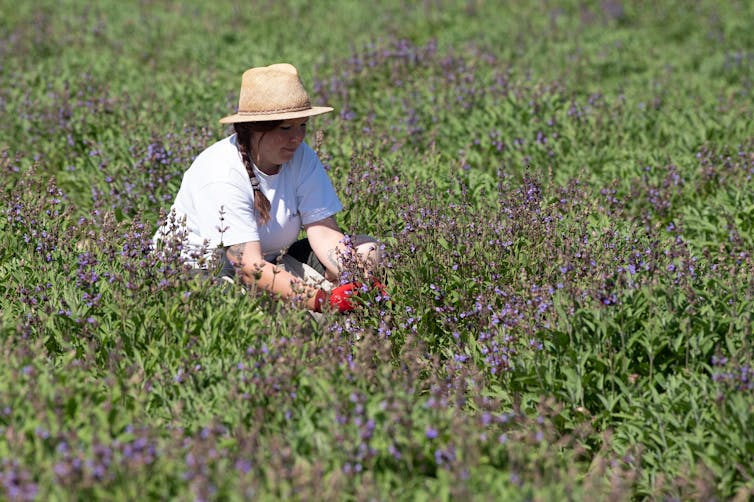Sage, sacred to Native Americans, is being used in purification rituals, raising issues of cultural
Native Americans are struggling to find sage for their spiritual practices as the plant is being overharvested for sale to the wider public.

White sage, which is sacred to a number of Native American tribes in the southwest United States, has been adopted by both some contemporary Pagans and New Age practitioners for purification rites. As Emily McFarlan Miller reported in a recent Religion News Service article, this is resulting in overharvesting and shortages of the plant, making it harder for Native Americans to find enough for their sacred ceremonies.
In her groundbreaking book “Purity and Danger,” anthropologist Mary Douglas illustrates how purity and its maintenance are central to religion. It is a way to keep danger at bay as well as provide a way to separate the sacred from the mundane.
As a sociologist of religion who has studied contemporary Paganism for more than 30 years, I am aware of how important both contact with the spirit world and purification are in this religion. Contemporary Paganism is a set of religions that base their practice on what is known about pre-Christian religions in Europe, mixed with literature, science fiction and personal inspiration.
Within these religions nature is viewed as sacred, to be celebrated and protected. The celebration of nature takes several forms, the most common being a series of rituals that commemorate the changing seasons. Cleansing is a way to provide a safe place to interact with the spirit world, which is always part of Pagan rituals.
Purification can be done using a number of substances, including salt, rosemary and sometimes white sage. When purification includes the use of sage, it raises the issue of appropriation, as it has traditionally been used by Native Americans in their rituals.
Protection and cleansing
Pagan rituals take place outdoors, when possible, or sometimes in people’s homes or in occult bookstores. There is no set liturgy that everyone follows, and it is possible for people to create their own rituals.
Because there is no dedicated sanctified place, cleansing and protection become particularly important within Paganism. More mainstream religions have buildings, such as churches or synagogues, where they maintain sanctuaries for religious purposes only.
Pagans, to the contrary, have ritual areas that must be transformed from mundane to sacred use. Possibly more importantly, rituals are meant to open up the individual to the spiritual or other world. Magic, the process of changing reality to your will through incantations, is done in this realm.
As I learned when I was doing my research, most Pagans believe entering this realm holds both great possibilities and dangers. The cleansing and purification of the place and the participants are meant to protect them by keeping out unsavory spirits.
Purification can be done in several ways. When I began my research in 1986, it was most commonly done using salt and water. At Pagan ceremonies that I attended as a researcher, those leading the ritual would “cut” a sacred circle. This entailed walking around the circle carrying a ritual knife known as an athame while chanting an incantation that marked the area as a safe place that only the spirits called would enter. They then used salt and water to purify the circle.
In some of the rituals participants were already standing in the circle when this part of the ritual was done; in others they entered afterward. The participants were also purified, with salt, water, smoke from a candle, incense or rosemary and a crystal or rock, symbolizing Mother Earth.
White sage and cultural appropriation
Sometimes white sage was used for purification in a ritual. It was used because it was associated with Native American practice. As religious studies scholar Sarah Pike found among contemporary Pagans, cultural borrowing from Native Americans was seen as connecting the participants to the spirits that lived in the land around them.
Participants believed they were honoring the first people on the continent by incorporating elements of their spiritual practice. Some of the Pagan practitioners had received training from a Native American teacher. For many contemporary Pagans, Native American spirituality was a practice they wanted to emulate because of its connection to the land, to a spirit world, and because it predates Christianity and is native to the region. As contemporary Pagans often piece together different elements to create their spirituality, for many it seemed natural to include Native American practices.
As Pike notes, in the early 1990s Native Americans from several tribes began to express their rage at what they saw as “cultural strip mining,” the stealing and watering down of their culture and their spirituality, which they described as an extension of colonization that had stripped them of their original lands. The use of sage was not the only cultural artifact that these Native American spokespeople objected to being used by nonnatives. Traditional dress and eagles’ feathers were two other examples of commonly appropriated items.
As Pagans pride themselves on being sensitive to practices of diverse cultures, most quickly gave up the use of sage; the use of other Native American artifacts in Pagan practices became less common as well. Those who had been using sage returned to using either salt and water or rosemary for purification.

The use of sage by non-Native Americans is again becoming more prevalent. I noticed while doing my research in 1986 that white sage was sold at stores catering to the occult. It is now being more widely marketed by stores such as Walmart and Anthropologie.
The market has become larger as aspects of Pagan or New Age practices have seeped into more general practice and the number of Pagans has increased. It has become common, for example, for younger Americans to cleanse their homes of bad spirits with white sage even if they do not identify as Pagans. Added to this, those who are new to Paganism are often unaware of the history of appropriation and are repeating the errors of an earlier generation of Pagans and using sage in their rituals
Native Americans who normally pick the herb as they need it are complaining that they are unable to find enough for their spiritual needs. Fears have also been raised that overharvesting could result in the plant’s becoming extinct, resulting in the extinction of the animals that are dependent on it as well.
It would be both ironic and sad if in celebrating Mother Earth, Pagans helped to make a sacred herb extinct.
Helen A. Berger receives funding from the Society for the Scientific Study of Religion, Association for the Sociology of Religion, and West Chester University.
Read These Next
West Coast levee failures show growing risks from America’s aging flood defenses
Levees protect more than 7 million buildings in the US today, yet they got a D-plus grade in 2025. A…
Has the Fed fixed the economy yet? And other burning economic questions for 2026
As 2026 begins, uncertainty is at the top of everyone’s mind.
The ‘sacred’ pledge that will power the relaunch of far-right militia Oath Keepers
Founder Stewart Rhodes says he will relaunch the group, serving as an important outlet for thousands…






